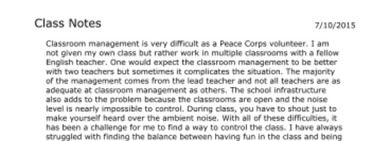"Students will demonstrate the ability to reflect and evaluate on
their own teaching practice, to evaluate theories, methods, techniques, and materials."
Reflecting and evaluating our own teaching practices is one of the most effective ways to continue to improve professionally. By reflecting on a class, I can focus on the parts of the lesson that were effective and those that need to be modified. I can also identify aspects of my teaching that need to be improved.
One way that I evaluate my teaching practice is by taking the time at the end of every class to reflect on the positive aspects of the lesson and the activities that were not as effective as I had planned. Using that information I am able to modify the lesson and present the material in a way that further benefits the students. During the time that I spend reflecting on my lessons, I also take notes in a teaching journal. The journal allows me to keep a record of the progression of my teaching practices as well as jot down questions that I would like to research later. Keeping a journal is particularly important for me because I have had limited formal observations of my teaching and personally reflecting on my own practices has helped me to develop my skills as a teacher. At the bottom of this page, you will find a few journal samples from my Peace Corps service.
As a Peace Corps volunteer, I almost always worked with another English teacher in the classroom. Although I was not being observed in a formal setting, I did have the opportunity to discuss my lessons and teaching style with my co-worker. This was a great way to reflect on my teaching practices because I received feedback from a fellow English teacher with knowledge of the students and education system. For instance, one teacher mentioned in her feedback that due to the varying levels of English in each class that some of the students did not understand the directions I gave them. This feedback has made me more aware of the way that I provide instructions to the students and has encouraged me to incorporate more visuals, repeat often, and use the whiteboard to give the students as many ways to understand the directions as possible. I have also learned a great deal from observing my co-workers in the classroom. For instance, I learned that directions have to be explicit and not leave anything open for debate. In Ecuador, students are accustomed to being told exactly what to do including what color pen to use and where to take their notes. In the U.S., I am more accustomed to students taking the initiative on their own to make decisions and interpret the instructions. This experience has enlightened me to the cultural differences that I might encounter in a future ESL classroom. I have become more specific with my instructions and manner of giving directions to a class. These are just a few of the many recommendations and suggestions that I received during my two years serving in Ecuador that have helped guide my teaching style.
Finally, I believe that it is important to create a classroom atmosphere that is positive and where the students are interested in learning. In order to achieve this goal, I have to create lessons that are interesting, fun, and include new teaching techniques. Sharing and researching teaching ideas has helped me to develop my lessons using the latest strategies and teaching techniques. As a guide for the students, it is my responsibility to ensure that the students have the opportunity to succeed in the classroom and reflecting after a lesson is essential for improvement.
